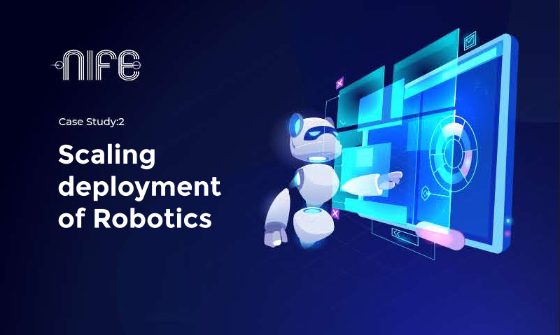Case Study 2: Scaling Deployment of Robotics
For scaling the robots, the biggest challenge is management and deployment. Robots have brought a massive change in the present era, and so we expect them to change the next generation. While it may not be true that the next generation of robotics will do all human work, robotic solutions help with automation and productivity improvements. Learn more!

Introduction#
In the past few years, we have seen a steady increase and adoption of robots for various use-cases. When industries use robots, multiple robots perform similar tasks in the same vicinity. Typically, robots consist of embedded AI processors to ensure real-time inference, preventing lags.
Robots have become integral to production technology, manufacturing, and Industrial 4.0. These robots need to be used daily. Though embedded AI accelerates inference, high-end processors significantly increase the cost per unit. Since processing is localized, battery life per robot also reduces.
Since the robots perform similar tasks in the same vicinity, we can intelligently use a minimal architecture for each robot and connect to a central server to maximize usage. This approach aids in deploying robotics, especially for Robotics as a Service use-cases.
The new architecture significantly reduces the cost of each robot, making the technology commercially scalable.
Key Challenges and Drivers for Scaling Deployment of Robotics#
- Reduced Backhaul
- Mobility
- Lightweight Devices
How and Why Can We Use Edge Computing?#
Device latency is critical for robotics applications. Any variance can hinder robot performance. Edge computing can help by reducing latency and offloading processing from the robot to edge devices.
Nife's intelligent robotics solution enables edge computing, reducing hardware costs while maintaining application performance. Edge computing also extends battery life by removing high-end local inference without compromising services.
Energy consumption is high for robotics applications that use computer vision for navigation and object recognition. Traditionally, this data cannot be processed in the cloud; hence, embedded AI processors accelerate transactions.
Virtualization and deploying the same image on multiple robots can also be optimized.
We enhance the solution's attractiveness to end-users and industries by reducing costs, offloading device computation, and improving battery life.
Solution#
Robotics solutions are valuable for IoT, agriculture, engineering and construction services, healthcare, and manufacturing sectors.
Logistics and transportation are significant areas for robotics, particularly in shipping and airport operations.
Robots have significantly impacted the current era, and edge computing further reduces hardware costs while retaining application performance.
How Does Nife Help with Deployment of Robotics?#
Use Nife to offload device computation and deploy applications close to the robots. Nife works with Computer Vision.
- Offload local computation
- Maintain application performance (70% improvement over cloud)
- Reduce robot costs (40% cost reduction)
- Manage and Monitor all applications in a single interface
- Seamlessly deploy and manage navigation functionality (5 minutes to deploy, 3 minutes to scale)
A Real-Life Example of Edge Deployment and the Results#

In this customer scenario, robots were used to pick up packages and move them to another location.
If you would like to learn more about the solution, please reach out to us!